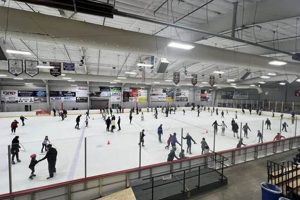The structured routine performed by a skater or skating pair, duo, or group during a competition comprises a sequence of required elements and artistic expression. These components are judged based on technical merit and presentation, contributing to the overall score. For example, a competitor might execute a series of jumps, spins, and footwork sequences choreographed to music.
The careful construction and execution of these routines are paramount to success in competitive skating. A well-designed routine maximizes scoring potential by incorporating elements that showcase the skater’s strengths while adhering to the regulations established by governing bodies. Historically, the emphasis on this aspect has evolved, with increased attention now placed on artistry and musical interpretation alongside technical proficiency.
The subsequent sections will delve into the various aspects contributing to the creation, execution, and judging of these structured routines, encompassing technical elements, artistic components, and the regulations that govern them.
Guidance for Routine Development
The following guidelines provide a framework for creating and optimizing a skater’s competitive presentation. Adherence to these principles can enhance both technical execution and artistic impression.
Tip 1: Strategic Element Selection: Prioritize elements that align with the skater’s strengths and skill set. Focus on mastering technically challenging elements within the skater’s capabilities rather than attempting those beyond their current proficiency. For example, a skater with strong jumping ability should incorporate more triple or quadruple jumps, while a skater skilled in spins should include more complex spin variations.
Tip 2: Choreographic Cohesion: Ensure a seamless connection between technical elements and the musical interpretation. Movements should complement the music’s rhythm, mood, and narrative. Avoid abrupt transitions or elements that appear disjointed from the overall artistic theme.
Tip 3: Rulebook Compliance: Maintain strict adherence to the rules and regulations outlined by the relevant skating federation. Familiarize oneself with point values, deduction criteria, and prohibited elements to maximize scoring potential and avoid penalties.
Tip 4: Performance Consistency: Develop a routine that can be reliably executed under competitive pressure. Focus on repeatable, stable performances rather than relying on high-risk elements that have a low probability of success. Regular practice and simulated competition environments are crucial for building consistency.
Tip 5: Creative Interpretation: Inject personal style and artistry into the presentation. Develop a unique performance character that resonates with the audience and judges. Originality and compelling storytelling can significantly enhance the overall impression score.
Tip 6: Optimize Layout: Efficient spatial usage on the ice surface can maximize judge assessment of performance quality and skater skill. A well thought out structure can give a greater perceived performance, even from similar skill level as peers.
Effective routine construction combines technical precision with artistic expression, resulting in a performance that resonates with both the judges and the audience. By prioritizing these guidelines, skaters can optimize their scoring potential and enhance their overall competitive experience.
The subsequent sections will address specific aspects of technical elements and judging criteria, providing a more in-depth understanding of the nuances of competitive skating.
1. Technical Element Execution
Technical element execution is a fundamental determinant of success within a structured skating routine. It directly influences the base value of a routine, as each jump, spin, and step sequence is assigned a specific point value based on its difficulty and quality. Faultless execution ensures the skater receives the maximum possible points for each element, contributing significantly to the overall score. Conversely, errors in execution, such as falls or incomplete rotations, result in point deductions and can substantially reduce the final tally. For example, a quad jump with a clean landing earns considerably more points than the same jump with a fall or downgraded rotation.
The impact of technical execution extends beyond the base value of individual elements. The quality of execution also affects the Grades of Execution (GOE) awarded by judges. Elements performed with exceptional precision, speed, and control receive positive GOE, further boosting the score. Conversely, poorly executed elements receive negative GOE, exacerbating the point loss due to technical errors. The stability and consistency of technical execution also influence the artistic components of the routine. A skater who can consistently and confidently execute difficult elements is better able to express artistry and connect with the audience.
In summary, technical element execution is inextricably linked to the overall effectiveness of a skating routine. Mastering technical skills is essential for maximizing scoring potential, achieving positive Grades of Execution, and creating a platform for artistic expression. Focusing on rigorous training and technique refinement is therefore critical for skaters striving for competitive success. Poor technical execution introduces many difficulties for skaters, from missing out on points and losing GOE to hampering the artistic component of performance.
2. Artistic Interpretation
Artistic interpretation is a crucial component of a skating routine, functioning as the conduit through which technical skill transforms into an engaging and emotionally resonant performance. It involves the skater’s ability to embody the music, express the chosen theme, and connect with the audience on an emotional level. A lack of artistic interpretation can render even the most technically proficient routine sterile and unmemorable, while a strong artistic performance can elevate a simpler routine, making it more compelling and impactful. The effect of artistic interpretation is manifested in the Program Component Scores (PCS) which, along with technical scores, determine a skaters placement.
Specifically, artistic interpretation impacts categories such as skating skills, transitions, performance, composition, and interpretation of the music. Skating skills involve the quality of edges and flow across the ice, which should be seamlessly integrated with the music’s rhythm and phrasing. Transitions, the connecting steps and movements between technical elements, should not be merely functional but expressive, adding to the overall narrative. Performance encompasses the skater’s charisma, projection, and ability to convey emotion. Composition concerns the overall structure and organization of the routine, ensuring a logical progression and visual appeal. Finally, musical interpretation is the explicit embodiment of the music’s character, mood, and story. For example, a routine set to a melancholic piece should reflect that mood through movement, facial expressions, and overall presentation, creating a cohesive and believable performance.
Understanding the importance of artistic interpretation offers practical benefits for skaters and coaches. It necessitates a shift in training focus from purely technical proficiency to holistic development. Skaters need to develop not only their physical skills but also their expressive abilities, learning to communicate emotions and tell stories through movement. Coaches must guide skaters in selecting appropriate music, choreographing routines that align with their strengths and personality, and refining their performance skills. Overcoming the challenge of effectively integrating artistry with technical elements requires ongoing effort and a deep understanding of the expressive potential of skating. This integration is key to producing memorable routines that resonate with judges and audiences alike, and contributes significantly to competitive success.
3. Musical Synchronization
Musical synchronization is an indispensable element within a structured skating routine. It reflects the degree to which a skater’s movements align with the rhythm, tempo, phrasing, and overall character of the selected music. A high degree of synchronization enhances the aesthetic appeal of the routine, creating a seamless fusion of athleticism and artistry. Conversely, poor synchronization can disrupt the flow of the routine, diminishing its impact and potentially lowering the score. The presence or absence of synchronization can dramatically influence judges’ evaluation of the program’s artistic merit, demonstrating its central importance in creating a compelling performance.
Real-world examples illustrate the practical significance of this aspect. Consider a skater executing a jump precisely on a musical accent, or a spin that builds in speed and intensity mirroring a crescendo in the music. These instances showcase a deep understanding of the music and the ability to translate its nuances into physical expression. Conversely, a skater who consistently misses musical cues, performs movements out of sync with the beat, or fails to reflect the music’s emotional tone presents a disjointed and less engaging performance. The impact on Program Component Scores (PCS) can be significant, as judges evaluate the performance based on its overall coherence and artistic impact. Elite skaters and choreographers often dedicate considerable time to meticulously matching movements to music, ensuring that every element of the routine is synchronized and purposeful.
In conclusion, musical synchronization represents a crucial link between the technical and artistic dimensions of a skating routine. It demands careful attention from skaters, choreographers, and coaches alike. The ability to interpret music and translate it into physical movement is essential for creating captivating and memorable performances. Mastering this skill not only elevates the aesthetic quality of the routine but also contributes significantly to its overall competitive success. Failure to prioritize musical synchronization can detract from the artistic impact, leading to lower scores and a less compelling performance.
4. Compositional Structure
Compositional structure within a structured skating routine refers to the arrangement and sequencing of technical elements and transitional movements to create a cohesive and visually appealing performance. The structure directly influences the flow, pacing, and overall impact of the routine. A well-constructed composition seamlessly integrates technical elements with artistic expression, maximizing scoring potential and enhancing audience engagement. Poor compositional structure, conversely, can result in a disjointed and uninspired routine, regardless of the technical proficiency of individual elements. For example, a routine featuring a series of disconnected jumps, without thoughtful transitions or thematic development, would demonstrate weak compositional structure.
The arrangement of elements impacts multiple aspects of the routine. The placement of more difficult or energy-intensive elements earlier in the routine may allow for cleaner execution but could sacrifice stamina for later, artistic sections. Conversely, placing those elements later could demonstrate endurance but risk reduced execution quality. The use of the ice surface also reflects compositional structure; varying patterns and strategic use of space add visual interest and allow the skater to connect with different sections of the audience. Furthermore, transitions are crucial in linking elements and maintaining flow. Effective transitions are not merely functional but contribute to the routine’s narrative and artistic impression. An example of good structure might include building momentum towards a dramatic jump with flowing steps, then resolving the energy with a graceful spin.
In summary, compositional structure is an integral component of a successful skating routine, directly impacting its aesthetic appeal and competitive scoring. Thoughtful planning of element placement, transitions, and ice surface usage is essential for creating a cohesive and engaging performance. The challenges involve balancing technical requirements with artistic expression and strategic pacing. Understanding and prioritizing compositional structure enhances the skater’s ability to communicate their artistic vision and maximize their competitive potential. Overlooking this element can result in a disjointed presentation and missed opportunities for achieving higher scores.
5. Adherence to Regulations
Compliance with established regulations is paramount to the validity and integrity of any structured skating routine. These rules, meticulously defined by governing bodies, dictate permissible elements, scoring criteria, and prohibited actions, shaping the boundaries within which a skater must operate. Failure to adhere to these regulations can result in penalties, deductions, and even disqualification, significantly impacting the skater’s overall performance and competitive standing.
- Element Validity
Regulations stipulate specific technical requirements for each jump, spin, and step sequence. These requirements pertain to the number of rotations, edge quality, landing position, and other technical aspects. A jump deemed under-rotated or performed on an incorrect edge, for instance, may be downgraded in value or even invalidated entirely, resulting in point deductions. Therefore, skaters must demonstrate precise technical execution to comply with these standards.
- Prohibited Elements and Movements
Certain elements or movements may be restricted or prohibited due to safety concerns, ethical considerations, or perceived lack of aesthetic value. For example, backflips are generally prohibited in competitive skating. Incorporating such elements into a routine results in immediate penalties and can negatively impact the overall impression on judges. Skaters and choreographers must remain informed about these restrictions to avoid inadvertent violations.
- Time Constraints
Routines are subject to strict time limits, varying based on the competition level and discipline. Exceeding the allotted time can incur point deductions. Skaters must carefully manage the duration of their performance, ensuring that all planned elements are executed within the prescribed timeframe without sacrificing artistic expression or technical quality. The structure and pace of the routine are critical to meet time demands.
- Costume and Presentation Guidelines
Governing bodies often establish guidelines regarding appropriate attire and presentation. These guidelines may address issues such as costume coverage, use of props, and overall appropriateness. Violations of these guidelines can lead to deductions or warnings from judges. Skaters must ensure their attire and presentation conform to these standards to maintain a professional and respectful image.
The aforementioned facets underscore the critical role of regulatory adherence in competitive skating routines. Understanding and complying with these regulations is not merely a formality but an essential component of strategic routine development and successful performance. Skaters and choreographers must prioritize regulatory awareness to maximize scoring potential and maintain the integrity of the sport. The complexities highlight the necessity of continuous learning and adaption for all members of the figure skating community.
Frequently Asked Questions
The following addresses common inquiries concerning the nature, construction, and evaluation of competitive skating presentations.
Question 1: What is the primary determinant of a routine’s base score?
The collective value of the successfully executed technical elements, including jumps, spins, and step sequences, directly establishes the base score. Each element carries a designated point value based on its difficulty, which contributes to this foundational assessment.
Question 2: How do judges assess the artistic merit of a skating presentation?
Artistic assessment encompasses various components, including skating skills, transitions, performance quality, composition, and interpretation of the music. These aspects contribute to the Program Component Scores (PCS), reflecting the skater’s ability to communicate artistry and emotional expression.
Question 3: What role does musical synchronization play in evaluating a skating routine?
Synchronization reflects the degree to which movements align with the music’s rhythm, tempo, and phrasing. A high degree of synchronization enhances the routine’s aesthetic appeal and contributes to positive artistic impressions, influencing the scoring process.
Question 4: How does compositional structure affect a program’s overall impact?
The strategic arrangement of technical elements, transitional movements, and use of ice surface dictate a program’s flow, pacing, and visual appeal. Effective composition enhances both the technical and artistic impact, contributing to a more cohesive and engaging presentation.
Question 5: What types of rule violations can lead to point deductions in competitive skating?
Deductions can arise from a variety of infractions, including under-rotated jumps, invalid elements, exceeding time limits, and non-compliance with costume regulations. Adherence to all applicable regulations is essential for maximizing the score and avoiding penalties.
Question 6: Besides technical execution, what elements contribute most to a compelling skating presentation?
Compelling performances emphasize a blend of artistry, emotional expression, musical interpretation, and seamless integration of elements, creating a captivating and memorable experience for both judges and audience members. A routine emphasizing connection is often preferrable.
In conclusion, the multifaceted evaluation of a skating program necessitates a balanced approach encompassing technical skill, artistic expression, and strict adherence to established regulations.
This article will now provide concluding remarks on the strategic development of structured routines.
Programme Skate
This exploration has underscored the multifaceted nature of the routines at the heart of competitive skating. The effective execution of a meticulously structured routine demands a confluence of technical mastery, artistic interpretation, and rigorous adherence to established regulations. Mastering the technical and understanding its artistic applications is the key of this skating’s routine. These elements are not discrete, but rather interconnected components contributing to a skater’s overall competitive success.
The development and refinement of such a routine requires a strategic approach, prioritizing element selection, choreographic cohesion, and consistent performance execution. Furthermore, a sustained commitment to understanding and adapting to evolving regulations is paramount. The meticulous construction and unwavering execution of structured routines represent the pinnacle of athletic and artistic achievement in this arena. Such efforts lead to the advancement of both competitive edge and creative exploration within the sport, influencing skaters and audiences alike.







